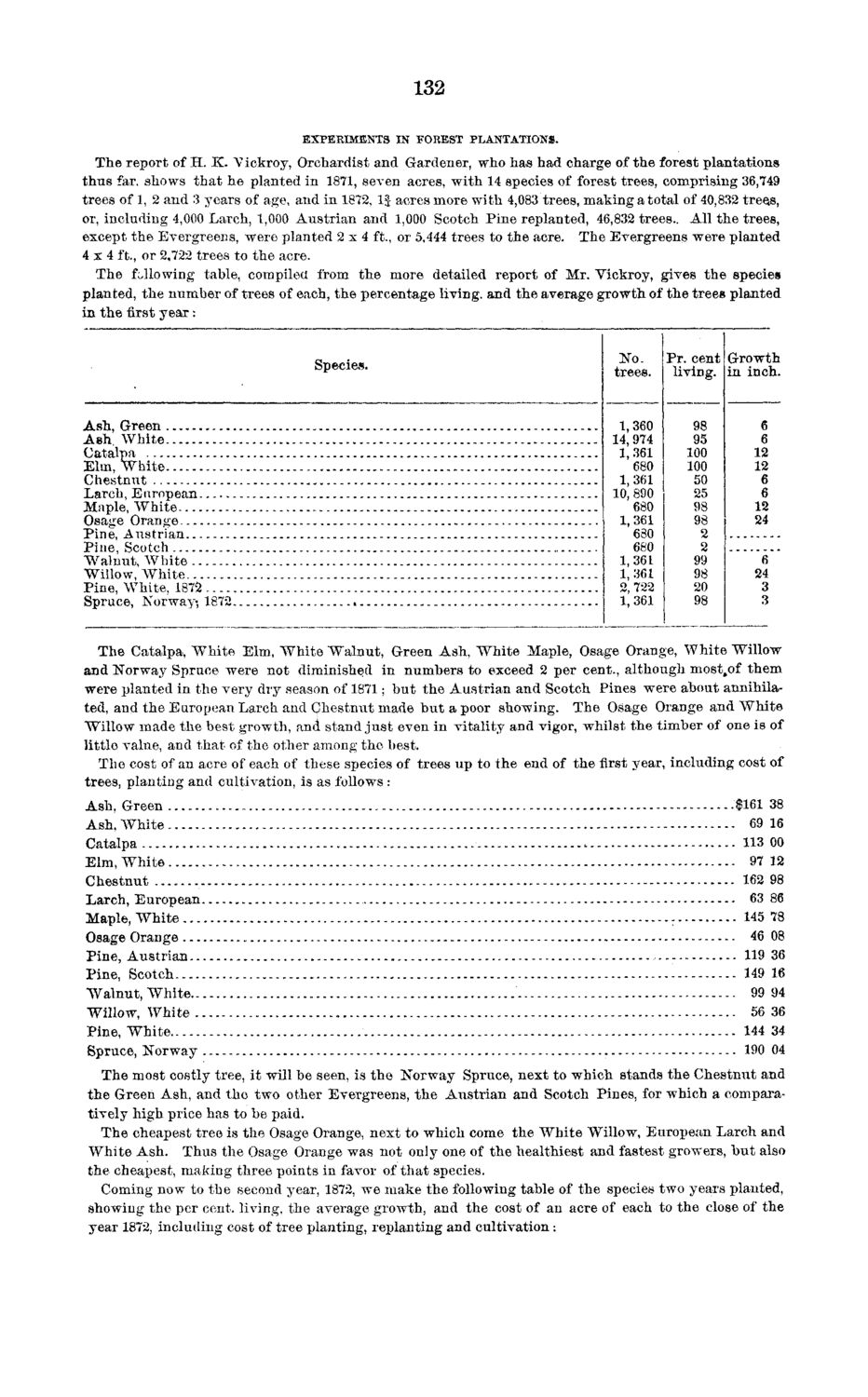| |
| |
Caption: Board of Trustees Minutes - 1873
This is a reduced-resolution page image for fast online browsing.

EXTRACTED TEXT FROM PAGE:
132 EXPERIMENTS IN FOREST PLANTATIONS. The report of H. K. Yickroy, Orchardist and Gardener, who has had charge of the forest plantations thus far. shows that he planted in 1871, seven acres, with 14 species of forest trees, comprising 36,749 trees of 1, 2 and 3 years of age, and in 1872, If acres more with 4,083 trees, making atotal of 40,832 tress, or, including 4,000 Larch, 1,000 Austrian and 1,000 Scotch Pine replanted, 46,832 trees.. All the trees, except the Evergreens, were planted 2 x 4 ft., or 5,444 trees to the acre. The Evergreens were planted 4 x 4 ft., or 2,722 trees to the acre. The fallowing table, compiled from the more detailed report of Mr. Yickroy, gives the species planted, the number of trees of each, the percentage living, and the average growth of the trees planted in the first year : Species. No. trees. Pr. cent Growth living. in inch. Ash, Green Ash. White Catalpa Elm, White Chestnut Larch, European Maple, White Osage Orange Pine, Austrian Pine, Scotch Walnut, White Willow, White Pine, White, 1872 . . . . Spruce, Norway*, 1872 1,360 14,974 1, 361 680 1,361 10, 890 1 1,361 680 680 1 680 1 1,361 1, 361 2, 722 1, 361 98 95 100 100 50 25 98 98 2 2 99 98 6 6 12 12 6 6 12 24 6 24 3 3 20 98 The Catalpa, White Elm, White Walnut, Green Ash, White Maple, Osage Orange, White Willow and Norway Spruce were not diminished in numbers to exceed 2 per cent., although most.of them were planted in the very dry season of 1871; but the Austrian and Scotch Pines were about annihilated, and the European Larch and Chestnut made but a poor showing. The Osage Orange and White Willow made the best growth, and stand just even in vitality and vigor, whilst the timber of one is of little value, and that of the other among the best. The cost of an acre of each of these species of trees up to the end of the first year, including cost of trees, planting and cultivation, is as follows : Ash, Green Ash, White Catalpa Elm, White Chestnut Larch, European Maple, White Osage Orange Pine, Austrian Pine, Scotch Walnut, White Willow, White Pine, White Spruce, Norway $161 38 69 16 113 00 97 12 162 98 63 86 145 78 46 08 119 36 149 16 99 94 56 36 144 34 190 04 - The most costly tree, it will be seen, is the Norway Spruce, next to which stands the Chestnut and the Green Ash, and tho two other Evergreens, the Austrian and Scotch Pines, for which a comparatively high price has to be paid. The cheapest tree is the Osage Orange, next to which come the White Willow, Eurox>ean Larch and White Ash. Thus the Osage Orange was not only one of the healthiest and fastest growers, but also the cheapest, making three points in favor of that species. Coming now to the second year, 1872, we make the following table of the species two years planted, showing the per cent, living, the average growth, and the cost of an acre of each to the close of the year 1872, including cost of tree planting, replanting and cultivation:
| |